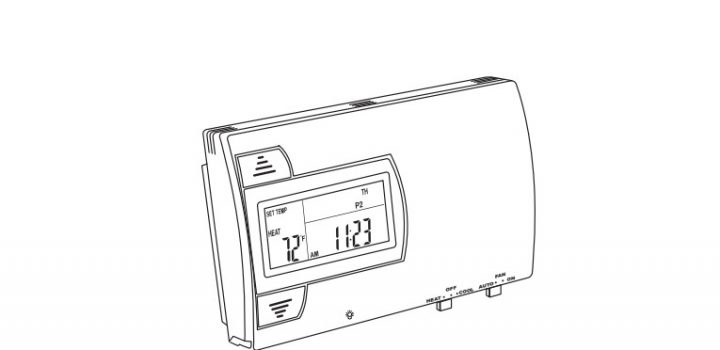Customer Support: 888-515-2585 or
Visit our website www.riteternp-thermostats.com
Caution :To avoid electrical shock and to prevent damage to the furnace, air conditioner, This can be done at the circuit breaker, or at the appliance
Tools
You will need #1 Phillips screwdriver (small) and Drill with 3/16-in. (4.8mm) bit for this installation.
Location
- On replacement installations, mount the new thermostat in place of the old one if possible.
- On new Installations, follow the guidelines listed below.
- Locate the thermostat on an inside wall, about 5 ft. (1.5m) above the floor, and in a room that is used often.
- Do not install it where there are unusual heating conditions, such as: in direct sunlight; near a lamp, radio, television, radiator register, or fireplace; near hot water pipes in a wall; near a stove on the other side of a wall.
- Do not locate in unusual cooling conditions, such as: on a wall separating an unheated room; or in a draft from a stairwell, door, or window.
- Do not locate in a damp area. This can lead to corrosion that will shorten thermostat life.
- Do not locate where air circulation is poor, such as: in a corner or an alcove; or behind an open door.
- Do not install the unit until all construction work and painting has been completed.
- This thermostat does not require leveling.
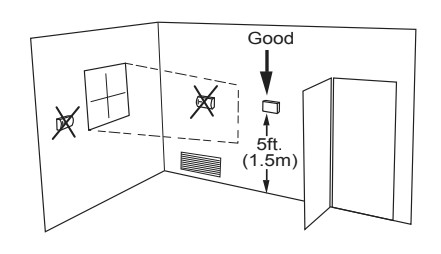
CAUTION
- Your thermostat is a precise instrument.
- Please handle it with care.
- Turn off electricity to the appliance before installing or servicing thermostat or any part of the system. Do not turn electricity back on until work is completed.
- Do not short (jumper) across electric terminals at control on furnace or air conditioner to test the system.
- This will damage the thermostat and void your warranty.
- All wiring must conform to local codes and ordinances.
- This thermostat is designed for use with 24 volt AC and millivolt systems. The thermostat should be limited to a maximum of 1.0 amps; higher amperage may cause damage to the thermostat.
2 Label Wires from Old Unit
- Switch electricity to the furnace and air conditioner OFF; then proceed with the following steps.
- Remove cover from old thermostat. Most are snap-on types and simply pull off. Some have locking screws on the side or front. These must be loosened.
- Note the letters printed near the terminals.
- Carefully attach labels (enclosed) to each wire. Label the wires one at a time.
You must have all the wires labeled before you proceed.
Caution: Read instructions carefully before removing any wiring from existing thermostat. Wire must be labeled before they are removed. THERE IS NO STANDARD COLOR CODE. When removing wires from their terminals, ignore the color of the wires since these may not comply with the standard.
3 Remove old unit
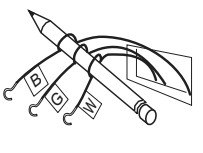
Remove the wires from the terminals of the old thermostat.
- Make sure the wires do not fall back inside the wall.
- Wind them around a pencil to keep them from falling.
- Remove the old thermostat from the wall. Fill wall opening with fiber glass insulation to prevent drafts.
4 Mount the 8050C
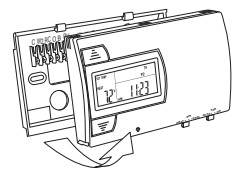
Separate front from back of unit. Press up on the catch on the bottom of the thermostat and swing the body away from the base, lift up to remove the body from the base.
Hold the base against the wall, with the wires coming through the opening below the terminal block.
Position the base for best appearance (If you choose to use the optional wall plate, hold the wall plate against the wall with the wires coming through the opening.)
Attach the base to the wall with the two screws provided.
If you are mounting the base to sheet rock or if you are using the old mounting holes, use the plastic anchors provided. Drill a 3/16-in. (4.8mm) hole for the insert at each screw location, and then mount the base.
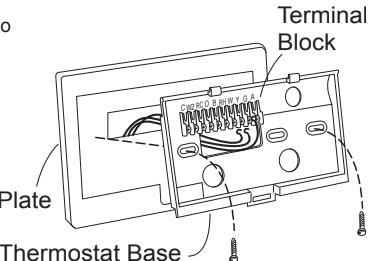
5 Gas-Electric Selection
REFER to the back of the Control Unit:
If you have Electric Heat or a Heat Pump you must place the Gas/Electric jumper in the ELECT position (thermostat controls the Fan).
If you have Gas Heat the Gas/Electric Jumper should be in the GAS position (furnace controls the Fan).
6 Heat Pump Switch
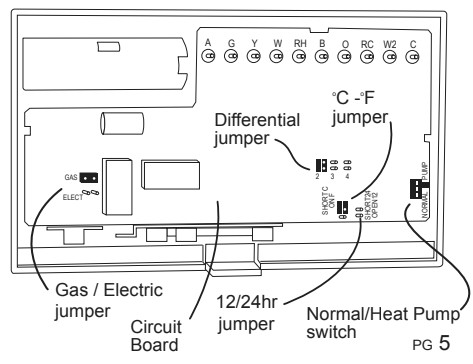
If you have a HEAT PUMP:
Change the NORMAL/PUMP switch on the back of the unit to PUMP.
If your heat pump has auxiliary heat, select the DIFFERENTIAL jumper is changed. This controls how often your auxiliary heat will come on. ‘2’ is most comfort (cold climates) ‘4’ is most efficient (warm climates)
The unit must be reset when a jumper is changed.
7 Install Batteries
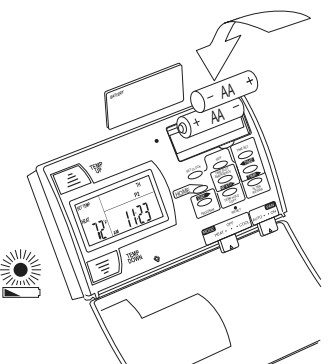
The 8050C requires batteries to operate your system and retain its programming in memory.
- Switch MODE switch to OFF and the FAN switch to AUTO.
- Insert 2 AA alkaline batteries according to the polarity noted in the compartment.
- Press the RESET button to clear the transient program memory. Initially, LCD display will go off.
NOTE: Replace the batteries when this LOW battery indicator appears on the display or once a year. With batteries removed, you have approximately 30sec before your custom programming is lost.
8 Power Options
Please be aware of the following power options
1) The 8050C can run on batteries only. (2AA Alkaline). The batteries will last well over 1 year. If the batteries are not replaced the thermostat will stop working.
2) The 8050C can run on the C wire if available. (24 VAC ONLY). As shown in the wiring diagrams, The C wire is the other side of the 24VAC heating transformer. If the C wire is used, the batteries are for AC power loss only and are not required.
9 Wire Connections
Make sure your wires are labeled. This is necessary to determine which step-by-step wiring diagram you should use. This may require you to find the ‘other end’ connection for each wire on your heating or air conditioning equipment and read the label there. If you have a Zoned Heating/Cooling system with multiple thermostats, please refer to our website at www.ritetemp-thermostats.com for installation notes or call 1-888-515-2585.
Before you Connect Wires
Please refer back to these guidelines for safe and secure wire connections.
- Take care not to damage the labels for each wire in handling.
- Strip insulation 3/8 in. (9.5mm) from wire ends.
- Connect labeled wires only to a terminal with corresponding letter.
- Bend the wire slightly, insert the wire under the contact plate and tighten the screw down onto the wire.
Caution: Do not allow wires to touch each other or parts on unit. Wires must be routed through the hole in the back plate, below the terminal block, or they will hit parts on the cover.
What Wires Do You Have?
The Wire chart shows wire labels used on Ritetemp thermostats. Please determine what wires you have and select the correct wiring diagram to “go to” on pages 9.
The Wire Chart below will help you determine the terminal connections you will use on your new thermostat. See chart section that applies to your heat/cool system.
| Old Thermostat | New Thermostat | Description | |
| ONE PowerWire | R or RH or 4 or V | RH or RC(leave jumper) | Power Wire |
| TWOPowerWire | R or 4 or VRC or R | RH (leave jumper) RC(leave jumper) | Power HeatPower Cool |
| Controlwires | W or H Y or MG or FC or XW2 or H2Y2 | WYGCW2do not connect | Heat returnCool return (compressor)Fan returnAC source for thermostat2nd stage of heat2nd stage of cool (n/a) |
| HEAT PUMPS | W2EO (see note below)B (see note below) | W2 OB | Heat pump Aux heatDo not connectDmpr/Chg-over (pwr in cool)Dmpr/Chg-over (pwr in heat) |
| ZONEDMOTORVALVES | 5 or R4 or W6 or Y or B | RHWA | Power Wire (pwr)Turn Valve onTurn Valve off |
| ZONEDSOLENOIDVALVES | RY or BW | RHWA | Power Wire (pwr)Turn Valve offTurn Valve on |
Note: On a heat pump, if O and B are both present, connect O to O and tape off B. For wiring support call 1-888-515-2585 or visit our website at www.ritetemp-thermostats.com
NOTE: Wires marked with dotted line are optional. The page references can be followed on the downloadable PDF version of the user manual
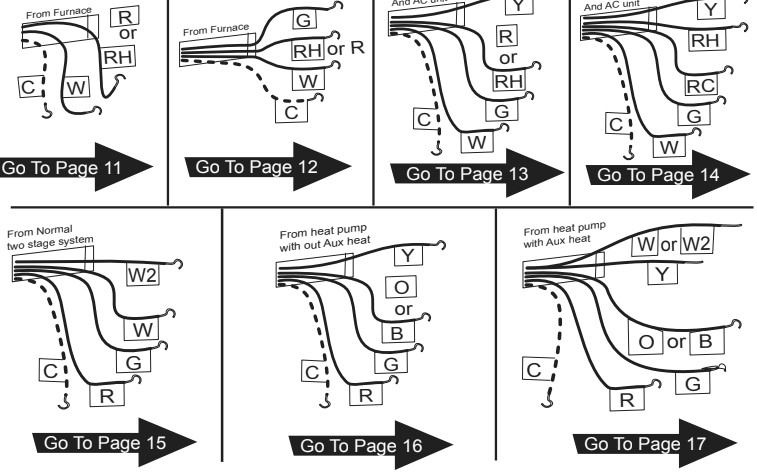
If you do not find the wiring information for your system try our website: www.ritetemp-thermostats.com for more information or call our customer service at 888-515-2585.
When you have finished connecting the wires attach control unit to wall unit. Hook the top of the body onto the base, swing the body down, and snap the body onto the base.
10 Check Unit
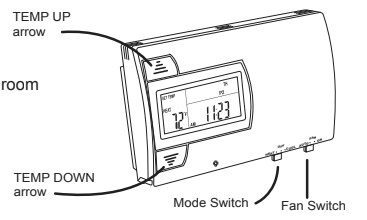
Follow these procedures to verify you have correctly installed the unit.
To check HEAT mode:
- Set the mode switch to HEAT. Set the fan switch AUTO.
- Using the TEMP UP button raise the set point to 90deg.
- Allow the system 5 min to respond.
- Verify that heat is blowing from the system.
- Set the mode switch to OFF.
To check COOL mode:
- Set the mode switch to COOL.
- Press the TEMP DOWN button to a temp 5° below room temperature.
- Allow the system 5 min to respond.
- Verify that cool air is blowing from the system.
- Set the mode switch to OFF.
To check Fan:
- Switch mode to OFF during fan test.
- Switch the FAN switch to the ON position. Verify air is blowing from vents.
- After test, return fan switch to AUTO, and mode to HEAT or COOL.
Congratulations, you have successfully installed your unit. Please proceed to the OPERATING GUIDE to initialize the new thermostat. REMEMBER, Mode switch must be in HEAT or COOL to operate.
2 Wire Wiring
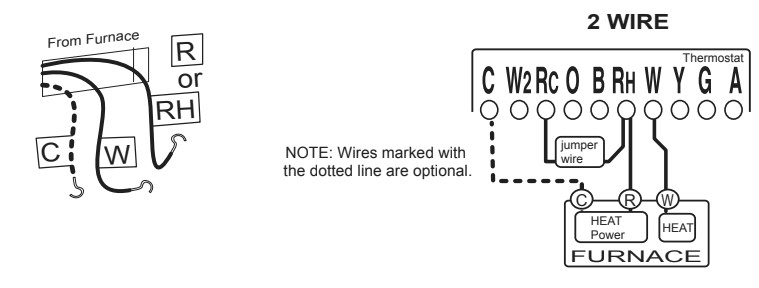
NOTE: Wires marked with the dotted line are optional.
- STEP 1 – Connect the R (or RH) wire to the RH terminal on the thermostat. This connects to the Heater Power.
- STEP 2 – Connect the W wire to the W terminal on the thermostat. This connects the heater control line to the thermostat.
Your heater is now connected to the thermostat.
NOTE: Wires marked with the dotted line are optional.
3 Wire Wiring
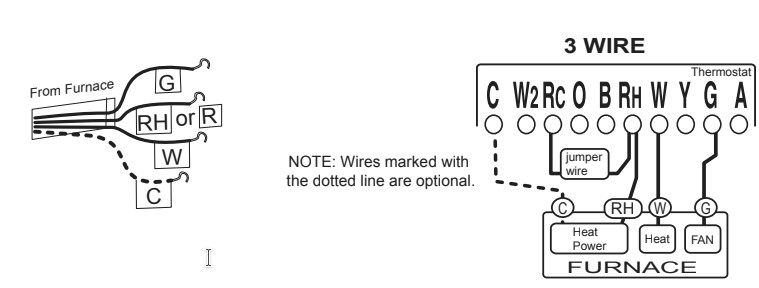
- STEP 1 – Connect the R (or RH) wire to the RH terminal on the thermostat. This connects to the Heater Power.
- STEP 2 – Connect the W wire to the W terminal on the thermostat. This connects the heater control line to the thermostat.
- STEP 3 – Connect the G wire to the G terminal on the thermostat. This connects the Fan to the thermostat.
Your system is now connected to the thermostat.
4 Wire Wiring
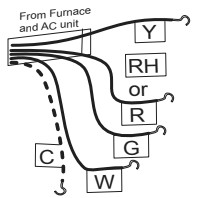
- STEP 1 – Connect the Y wire 4 WIRE son-neat pump to the Y terminal on the thermostat. This connects to the Cooler compressor.
- STEP 2 – Connect the RH or R wire to the RH terminal on the thermostat. This connects the Heater/Cooler Power.
- STEP 3 – Connect the W wire to the W terminal on the thermostat. This connects to the heater control line.
- STEP 4 – Connect the G wire to the G terminal on the Thermostat. This connects to the Fan.
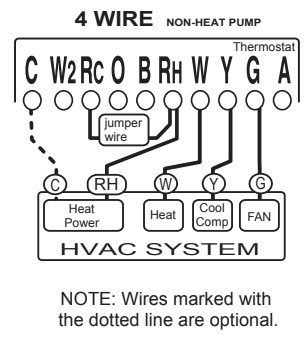
NOTE: Wires marked with the dotted line are optional.
Your HVAC system is now connected to the thermostat.
5 Wire Wiring
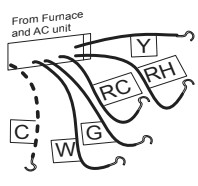
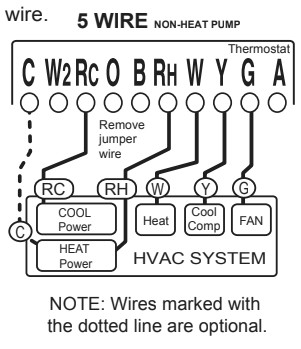
- STEP 1 – Remove the Jumper wire.
- STEP 2 – Connect the Y wire to the Y terminal on the thermostat. This connects to the Cooler compressor.
- STEP 3 – Connect the RH wire to the RH terminal on the thermostat. This connects to the Heater Power.
- STEP 4 – Connect the RC wire to the RC terminal on the thermostat. This connects to the Cooling Power.
- STEP 5 – Connect the W wire to the W terminal on the thermostat. This connects to the heater control line.
- STEP 6 – Connect the G wire to the G terminal on the Thermostat. This connects to the Fan. CCRC ERLO
NOTE: Wires marked with the dotted line are optional
Your HVAC system is now connected to the thermostat.
NORMAL 2 Stage Heat System
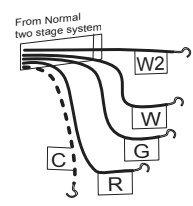
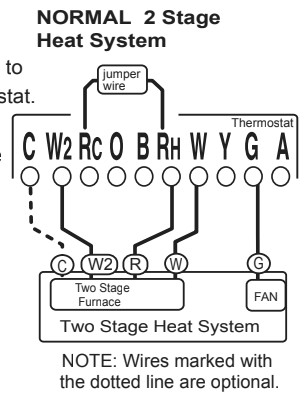
- STEP 1 – Connect the G wire to the G terminal on the thermostat. This connects the Fan.
- STEP 2 – Connect the W wire to the W terminal. This connects the 1st stage heat.
- STEP 3 – Connect the W2 wire to the W2 terminal. This connects the 2nd stage heat.
- STEP 4 – Connect the R wire to the RH terminal on the Thermostat. This connects to the 24vac power.
NOTE: Wires marked with the dotted line are optional.
Your HVAC system is now connected to the thermostat. (If the system also has AC, connect the Y wire to the ¥Y terminal on the thermostat. You may also have a RC wire if so remove jumper wire between RH and RC and connect the RC wire to the RC terminal.)
HEAT PUMP w/o Auxiliary Heat
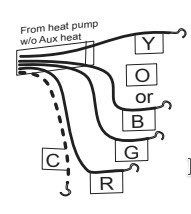
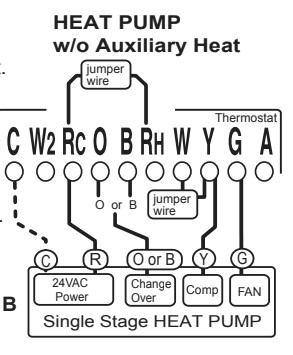
- STEP 1 – Connect the G wire to the G terminal on the thermostat. This connects the Fan.
- STEP 2 – Add a jumper wire between W and Y.
- STEP 3 – Connect the Y wire to the Y terminal on the thermostat. This connects the Compressor.
- STEP 4 – Connect the O or B wire to the terminal on the thermostat. (If you have both O and B wires, use the O and tape off the B.) This connects the change over valve.
- STEP 5 – Connect the R wire to the RC terminal on NOTE: Wires marked with the Thermostat. This connects to the 24vac power.
NOTE: Wires marked with the dotted line are optional.
Your HVAC system is now connected to the thermostat.
HEAT PUMP with Auxiliary Heat
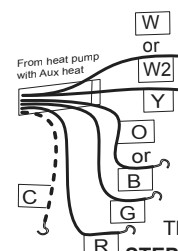
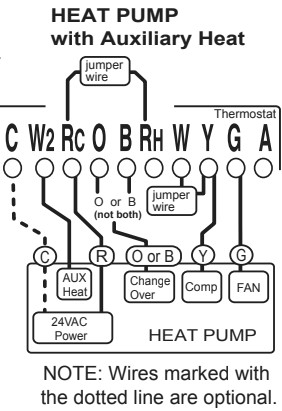
- STEP 1 – Connect the G wire to with Auxiliary Heat the G terminal on the thermostat. This connects the Fan.
- STEP 2 – Add a jumper wire Thermostat between W and Y.
- STEP 3 – Connect the Y wire to the Y terminal on the thermostat. This connects the Compressor.
- STEP 4 – Connect the O or B wire to the O or B terminal on the thermostat. (If you have both O and B wires, use the O and tape off the B). This connects the change over valve.
- STEP 5 – Connect the R wire to the RC terminal on the Thermostat. This connects to the 24vac power.
- STEP 6 – Connect W or W2 to W2 on the thermostat. This connects the AUX heat.
NOTE: Wires marked with the dotted line are optional.
Your HVAC system is now connected to the thermostat.
8050C Features
The 8050C can be used with most 24-volt gas, oil or electric heating and air conditioning systems, all heat pumps, and gas millivolt heating systems. It cannot be used with 120 volt heating systems. Ask The Home Depot for other thermostats to control line voltage systems.
The 8050C is programmable. There are 4 programming periods per day. Each period can be programmed separately.
You can use the built-in time/temperature programs, or alter them to suit your schedule. The 8050C separately programs each day of the week for both heating and cooling. You can easily override the programmed temperatures for as little as one programming period or up to an entire vacation.
The large backlit liquid crystal display shows time, day of the week, room and set temperatures. It will also remind you when the filter should be changed in your blower. Temperature swing adjustment lets you fine-tune your system for maximum comfort and energy efficiency.
A 5-minute minimum off time protects your compressor system from being damaged.
Two “AA” batteries are used to retain your time and temperature programs and to run the thermostat.
You can download the complete PDF version of the Ritetemp installation guide for 8050 thermostat here.
